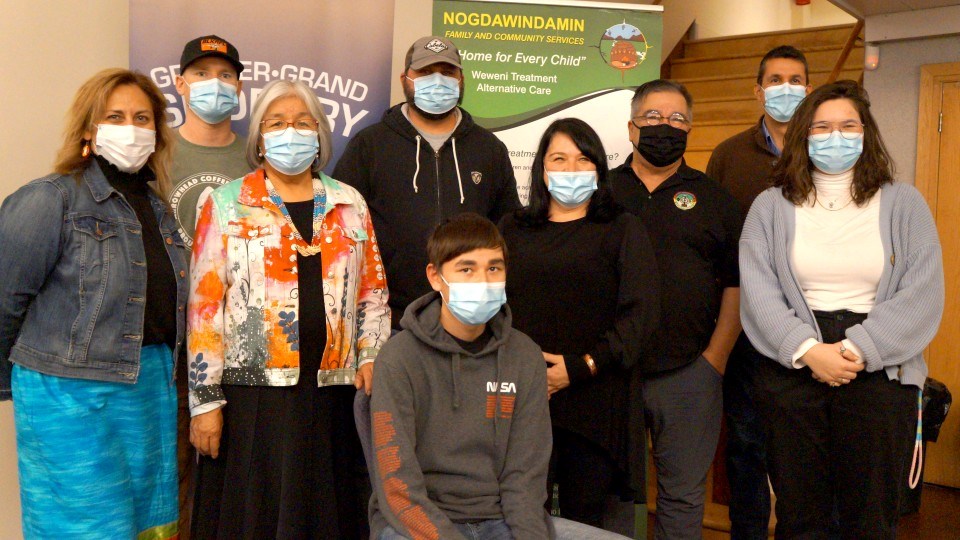A great feast held Nov. 30 in Sudbury was the culmination of the Greater Sudbury Police Services’ Mooz Akinonmaaget Maa Aki (Moose Who Teaches Land Survival) project, a chance to enjoy the success of both the moose hunt, and the program itself.
First created in June of this year by GSPS Det.-Const. Darrell Rivers of Wiikwemkoong Unceded Territory, the program was a partnership between Kina Gbezhgomi Child & Family Services, Nogdawindamin Family & Community Services and Niijaansinaanik Child and Family Services to create a pilot designed to both offer cultural teachings and learnings, to create positive relationships with as well as to ensure that youth know there is a person behind the uniform, Rivers told Sudbury.com.
“Because sometimes, when we get into unfortunate situations, All they remember is the uniform,” said Rivers. “So to put a face behind that uniform was great.”
Six local teen boys were able to participate in a moose hunt with Indigenous officers and guides, as well as non-Indigenous officers. Though the youth participants and non-Indigenous officers did not take part in the actual hunt due to Ministry of Natural Resources regulations, the Indigenous officers showed the Indigenous youth how to call and ‘rub’ for moose, as well as how to field dress any successful harvest.
It was the calling and the rubbing that were favourite moments for youth participants, including Falcon Desmoulin of Wiikwemkoong. Though he was not directly involved in the hunt as he was too young, he enjoyed learning how to rub with an antler and how to call for moose, which he described as pretty funny sounding.
He heard a moose call back a few times, but didn’t see it as they needed to stay safely back, allowing those legally registered to take the moose.
“Hearing them call back and stuff and smelling them — because you could actually smell it there,” said Desmoulins, speaking of the scent that male moose use to attract females. “You could smell that from them. And seeing their tracks in there, and the remains were pretty cool.”
After the great feast, the proceeds from the hunt will be donated to the Shkagamik-Kwe Health Centre’s Indigenous Food Bank.
But in addition to the chance to form better relationships with police, and to learn about hunting, the cultural teachings that were a part of the hunt; these land-based learnings help add a connection that is missing for many youth.
Not only did Rivers incorporate the seven grandfather teachings into the program, but each aspect of the hunt was sacred and ceremonial, rrom the giving of tobacco to the forest, to the special way of honouring the life of the moose. Mary Elliot, elder in residence at Nogdawindamin, told Sudbury.com the lessons learned in this program will teach the interconnectedness of the natural world.
“That land-based education is important to establish that relationship to the land, Mother Earth, to know that you are related to all of creation,” said Elliot.
Even when an animal is hunted, the sacrifice is honoured.
“When that animal is taken, he gave his life up for us to live,” said Elliot. “And we have to honour that spiritually.”
She notes that there are many different types of ceremonies, as in the Cree nation, where the women exit first, pulling the moose’s remains out of the bush with a long rope. Within the Anishnaabe tradition, as Elliot’s mother told her, the bell of the moose — the long flap of skin that hangs under a moose’s chin, also call a dewlap — is not to be removed from the bush. It is to be hung from a tree.
“When you leave that bell up there, you're acknowledging the sacrifice that this animal has given,” said Elliot. “Then the other animals see and know that that moose gave us life, gave its life to the Anishnaabe, for the First Nations, and it will be honoured.”
Juanita Skruibis, director of services for Nogdawindamin, said these teachings are also helpful for those who have had the teachings taken from them, or haven’t had access.
This is a really good opportunity for our urban youth to go out on the land,” said Skruibis. “Sometimes we take it for granted that in Northern Ontario, we're so close to nature, but for our urban youth, they don't always have the opportunities to go out on the land and have those opportunities of hunting and gathering.”
And the benefits of hearing the teachings while on the land imbue them with greater significance.
“The seven grandfather teachings, they went out on the land to do that. And when we harvest moose, it is a ceremony. It's the offering of the tobacco, acknowledging that spirit. And today with today's event, it's the feast of that spirit.”
Rivers said not only did the program offer new tools and understanding for non-Indigenous officers, but the youth participants had a chance to develop new skills, but also, their confidence. “To watch the kids when they first started, they're shy, a little introverted,” said Rivers. “And then as the program progressed throughout the summer, they got comfortable with each other, they got comfortable with the officers.” Rivers said by the end of the hunt, “they were joking around, they were running over camp, they were trying to talk to our officers, having fun. The goal was to build and rebuild relationships. And I truly believe we did that.”
Though the youth that were selected for the program through referrals from the child and family services organizations all identify as male, the program was and will be open to all genders, including non-binary and two-spirit individuals.
Rivers was thrilled with the program and very much hopes to continue it next year. While he would love to allow more youth participants, and will soon, he wants to ensure that the quality of the programming is available, and the hunt will remain a sacred and deeply memorable experience.
